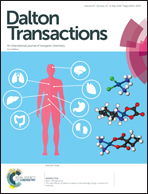Formation and selection of the macrocycle [{(tBuN![[double bond, length as m-dash]](https://www.rsc.org/images/entities/char_e001.gif) )P(μ-NtBu)}2(μ-Se)2{P(μ-NtBu)}2]3†
)P(μ-NtBu)}2(μ-Se)2{P(μ-NtBu)}2]3†
Abstract
Main group inorganic macrocycles, based on p-block element backbones other than carbon, are a challenging synthetic target that has been largely overlooked. In this study, we show that a simple strategy based on the combination of electrophilic and nucleophilic phosphazane building blocks can be extended to readily accessible [E(tBuN)P(μ-NtBu)]22− nucleophilic components, as exemplified by the Se-bridge PIII/PV phosphazane macrocycle [{(tBuN![[double bond, length as m-dash]](https://www.rsc.org/images/entities/char_e001.gif) )PV(μ-NtBu)}2(μ-Se)2{PIII(μ-NtBu)}2]3.
)PV(μ-NtBu)}2(μ-Se)2{PIII(μ-NtBu)}2]3.
![Graphical abstract: Formation and selection of the macrocycle [{(tBuN [[double bond, length as m-dash]] )P(μ-NtBu)}2(μ-Se)2{P(μ-NtBu)}2]3](/en/Image/Get?imageInfo.ImageType=GA&imageInfo.ImageIdentifier.ManuscriptID=C8DT01143E&imageInfo.ImageIdentifier.Year=2018)


 Please wait while we load your content...
Please wait while we load your content...
![[double bond, length as m-dash]](https://www.rsc.org/images/entities/h2_char_e001.gif) )P(μ-NtBu)}2(μ-Se)2{P(μ-NtBu)}2]3
)P(μ-NtBu)}2(μ-Se)2{P(μ-NtBu)}2]3